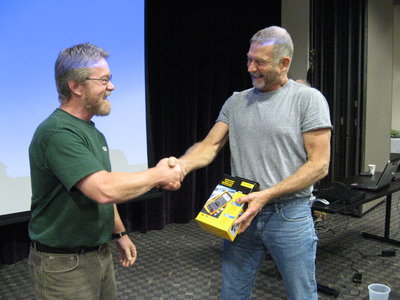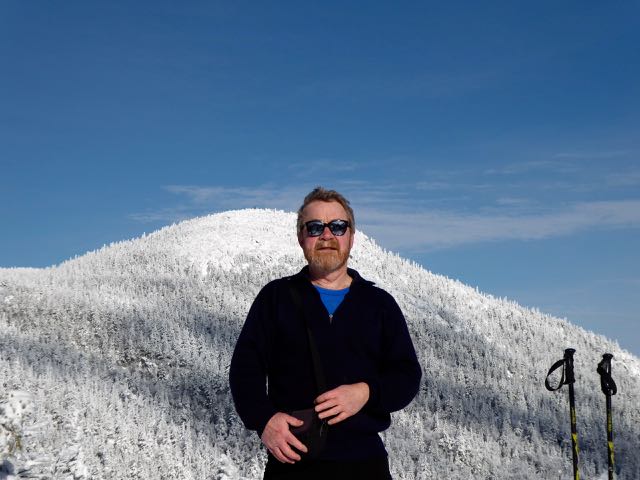Featuring Tom Moye, Mobile Sources Section Chief for the Department of Environmental Conservation
It’s hard to defend something that you can’t see, touch, feel, or taste, yet all of us depend on it every second of every day. Tom Moye, an environmental scientist with the Department of Environmental Conservation, has fought to protect Vermont’s air quality. On the national scale, he’s gone up against some of the most high-profile lawyers in the country and won in defense of Vermont’s air. The case involved auto manufacturers going to court to try to prevent Vermont from adopting greenhouse gas standards for vehicles. Tom also makes a big impact locally. He created and hosts monthly classes for auto technicians to help them get the latest emissions repair training and information, so these technicians can properly fix your cars and trucks. Whether it’s the large scale or the local scale, Tom’s mission is to look out for the unseen air all around us, making sure it’s safe and clean to breathe.
For most of the 20th century, Americans didn’t worry about their vehicle’s emissions. In fact, it wasn’t until the 1990 amendments to the Clean Air Act that significant programs were put in place to reduce the pollution coming out of our tailpipes. In Vermont, vehicles are the largest source of smog-forming pollutants, and more than 40 percent of greenhouse gases come from cars and trucks, representing the largest single source of air pollution.
“The country was focused on controlling pollution from stationary sources like industries and power plants. We hadn’t started thinking about managing pollution from our tailpipes. But in the late 1980s, people began realizing that cars and trucks were the largest source – and still are the largest source of air pollution – in Vermont. In the early 1990s, I worked with the State to start a program that tackled tailpipe pollution. We implemented a vehicle emissions inspection program and helped the state adopt California’s clean air standards for cars and trucks, allowing us to make sure all vehicles sold in Vermont had some of the lowest emissions in the nation.”

Tom also runs a training program for Vermont’s automotive technicians. Ten trainings are offered every year in towns across the state, from Newport to Bennington. The trainings are at night to allow auto techs to come after work. The program began 20 years ago after Tom saw a need to help equip these technicians with skills and know-how to repair emissions-related issues in cars and trucks. Since its inception, the program has trained nearly 4,000 auto technicians in Vermont.
“The training program is all about making sure we as an Agency walk our talk. If we’re saying we want to cut down on auto emissions and we announce goals to reduce statewide greenhouse gas emissions and other pollutants, it’s crucial for us to meet folks halfway and help them reach these goals together. That’s why we created this training program – to work directly with auto technicians and share ways to effectively diagnose and repair emissions problems in motor vehicles. This has a direct and immediate effect on our air quality and the technicians appreciate our help. It’s tough to keep up with ever-changing technological and regulatory requirements and they appreciate that someone from the state is trying to help them do their jobs better. It’s a win-win because the technicians are ground zero for pollution reductions from motor vehicles and they’re helping Vermonters get their cars fixed at the same time. On top of that, by learning the latest in their trade, they’re able to keep their business on the cutting edge.”
 Tom’s dad was in the auto repair business and he’d work for him as a kid growing up. He also has a lot of friends who own independent repair businesses. “They’re some of the smartest guys around and they’re some of the hardest working. They’ve got a tough job, it’s hard to stay current with the rapid technical innovations in the auto industry and they don’t often have the resources to keep up. They own small shops in small towns so when they need a little extra help to get up to date when it comes to emissions repairs, I’m glad we’re able to support them.”
Tom’s dad was in the auto repair business and he’d work for him as a kid growing up. He also has a lot of friends who own independent repair businesses. “They’re some of the smartest guys around and they’re some of the hardest working. They’ve got a tough job, it’s hard to stay current with the rapid technical innovations in the auto industry and they don’t often have the resources to keep up. They own small shops in small towns so when they need a little extra help to get up to date when it comes to emissions repairs, I’m glad we’re able to support them.”
“To me, it’s all about making a big difference at the local level,” Tom says. “I want to work on efforts that benefit everyone. When’s the last time you breathed? Sure, we could all walk around with scuba tanks on, but that’s not very practical. I’m trying to help improve the air we’re all consuming so that at the end of the day, everyone is a bit healthier, safer and happier.”
When Tom’s not working to protect Vermont’s air, he can be found on his sailboat on Lake Champlain or out on the trails that wind through the Worcester Mountains. “I love the Worcester Range because it’s less crowded than the Greens and has some great views.” It should come as no surprise that a man fighting to keep the air clear and visible year-round enjoys the breathtaking views atop Mt. Hunger.

